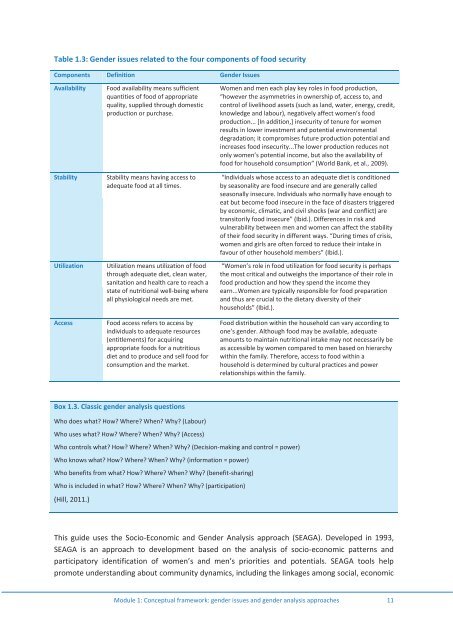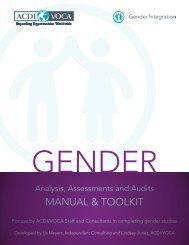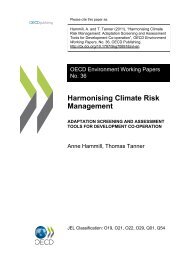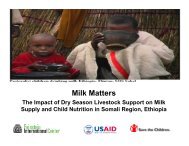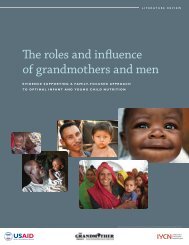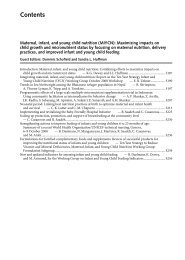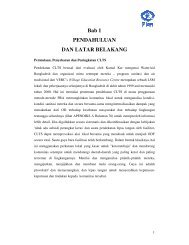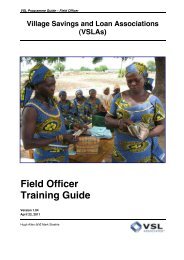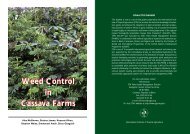Gender and climate change research in - FAO
Gender and climate change research in - FAO
Gender and climate change research in - FAO
You also want an ePaper? Increase the reach of your titles
YUMPU automatically turns print PDFs into web optimized ePapers that Google loves.
Table 1.3: <strong>Gender</strong> issues related to the four components of food security<br />
Components Def<strong>in</strong>ition <strong>Gender</strong> Issues<br />
Availability<br />
Stability<br />
Utilization<br />
Access<br />
Food availability means sufficient<br />
quantities of food of appropriate<br />
quality, supplied through domestic<br />
production or purchase.<br />
Stability means hav<strong>in</strong>g access to<br />
adequate food at all times.<br />
Utilization means utilization of food<br />
through adequate diet, clean water,<br />
sanitation <strong>and</strong> health care to reach a<br />
state of nutritional well-be<strong>in</strong>g where<br />
all physiological needs are met.<br />
Food access refers to access by<br />
<strong>in</strong>dividuals to adequate resources<br />
(entitlements) for acquir<strong>in</strong>g<br />
appropriate foods for a nutritious<br />
diet <strong>and</strong> to produce <strong>and</strong> sell food for<br />
consumption <strong>and</strong> the market.<br />
Women <strong>and</strong> men each play key roles <strong>in</strong> food production,<br />
“however the asymmetries <strong>in</strong> ownership of, access to, <strong>and</strong><br />
control of livelihood assets (such as l<strong>and</strong>, water, energy, credit,<br />
knowledge <strong>and</strong> labour), negatively affect women’s food<br />
production... [In addition,] <strong>in</strong>security of tenure for women<br />
results <strong>in</strong> lower <strong>in</strong>vestment <strong>and</strong> potential environmental<br />
degradation; it compromises future production potential <strong>and</strong><br />
<strong>in</strong>creases food <strong>in</strong>security...The lower production reduces not<br />
only women’s potential <strong>in</strong>come, but also the availability of<br />
food for household consumption” (World Bank, et al., 2009).<br />
“Individuals whose access to an adequate diet is conditioned<br />
by seasonality are food <strong>in</strong>secure <strong>and</strong> are generally called<br />
seasonally <strong>in</strong>secure. Individuals who normally have enough to<br />
eat but become food <strong>in</strong>secure <strong>in</strong> the face of disasters triggered<br />
by economic, climatic, <strong>and</strong> civil shocks (war <strong>and</strong> conflict) are<br />
transitorily food <strong>in</strong>secure” (Ibid.). Differences <strong>in</strong> risk <strong>and</strong><br />
vulnerability between men <strong>and</strong> women can affect the stability<br />
of their food security <strong>in</strong> different ways. “Dur<strong>in</strong>g times of crisis,<br />
women <strong>and</strong> girls are often forced to reduce their <strong>in</strong>take <strong>in</strong><br />
favour of other household members” (Ibid.).<br />
“Women’s role <strong>in</strong> food utilization for food security is perhaps<br />
the most critical <strong>and</strong> outweighs the importance of their role <strong>in</strong><br />
food production <strong>and</strong> how they spend the <strong>in</strong>come they<br />
earn...Women are typically responsible for food preparation<br />
<strong>and</strong> thus are crucial to the dietary diversity of their<br />
households” (Ibid.).<br />
Food distribution with<strong>in</strong> the household can vary accord<strong>in</strong>g to<br />
one’s gender. Although food may be available, adequate<br />
amounts to ma<strong>in</strong>ta<strong>in</strong> nutritional <strong>in</strong>take may not necessarily be<br />
as accessible by women compared to men based on hierarchy<br />
with<strong>in</strong> the family. Therefore, access to food with<strong>in</strong> a<br />
household is determ<strong>in</strong>ed by cultural practices <strong>and</strong> power<br />
relationships with<strong>in</strong> the family.<br />
Box 1.3. Classic gender analysis questions<br />
Who does what How Where When Why (Labour)<br />
Who uses what How Where When Why (Access)<br />
Who controls what How Where When Why (Decision-mak<strong>in</strong>g <strong>and</strong> control = power)<br />
Who knows what How Where When Why (<strong>in</strong>formation = power)<br />
Who benefits from what How Where When Why (benefit-shar<strong>in</strong>g)<br />
Who is <strong>in</strong>cluded <strong>in</strong> what How Where When Why (participation)<br />
(Hill, 2011.)<br />
This guide uses the Socio-Economic <strong>and</strong> <strong>Gender</strong> Analysis approach (SEAGA). Developed <strong>in</strong> 1993,<br />
SEAGA is an approach to development based on the analysis of socio-economic patterns <strong>and</strong><br />
participatory identification of women’s <strong>and</strong> men’s priorities <strong>and</strong> potentials. SEAGA tools help<br />
promote underst<strong>and</strong><strong>in</strong>g about community dynamics, <strong>in</strong>clud<strong>in</strong>g the l<strong>in</strong>kages among social, economic<br />
Module 1: Conceptual framework: gender issues <strong>and</strong> gender analysis approaches 11


